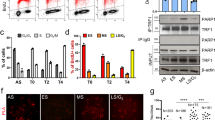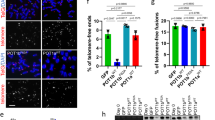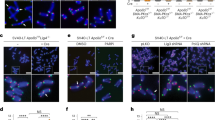Abstract
Maintenance of telomeres requires both DNA replication and telomere ‘capping’ by shelterin. These two processes use two single-stranded DNA (ssDNA)-binding proteins, replication protein A (RPA) and protection of telomeres 1 (POT1). Although RPA and POT1 each have a critical role at telomeres, how they function in concert is not clear. POT1 ablation leads to activation of the ataxia telangiectasia and Rad3-related (ATR) checkpoint kinase at telomeres1,2, suggesting that POT1 antagonizes RPA binding to telomeric ssDNA. Unexpectedly, we found that purified POT1 and its functional partner TPP1 are unable to prevent RPA binding to telomeric ssDNA efficiently. In cell extracts, we identified a novel activity that specifically displaces RPA, but not POT1, from telomeric ssDNA. Using purified protein, here we show that the heterogeneous nuclear ribonucleoprotein A1 (hnRNPA1) recapitulates the RPA displacing activity. The RPA displacing activity is inhibited by the telomeric repeat-containing RNA (TERRA) in early S phase, but is then unleashed in late S phase when TERRA levels decline at telomeres3. Interestingly, TERRA also promotes POT1 binding to telomeric ssDNA by removing hnRNPA1, suggesting that the re-accumulation of TERRA after S phase helps to complete the RPA-to-POT1 switch on telomeric ssDNA. Together, our data suggest that hnRNPA1, TERRA and POT1 act in concert to displace RPA from telomeric ssDNA after DNA replication, and promote telomere capping to preserve genomic integrity.
This is a preview of subscription content, access via your institution
Access options
Subscribe to this journal
Receive 51 print issues and online access
$199.00 per year
only $3.90 per issue
Buy this article
- Purchase on Springer Link
- Instant access to full article PDF
Prices may be subject to local taxes which are calculated during checkout




Similar content being viewed by others
References
Guo, X. et al. Dysfunctional telomeres activate an ATM-ATR-dependent DNA damage response to suppress tumorigenesis. EMBO J. 26, 4709–4719 (2007)
Denchi, E. L. & de Lange, T. Protection of telomeres through independent control of ATM and ATR by TRF2 and POT1. Nature 448, 1068–1071 (2007)
Porro, A., Feuerhahn, S., Reichenbach, P. & Lingner, J. Molecular dissection of TERRA biogenesis unveils the presence of distinct and multiple regulatory pathways. Mol. Cell Biol. 30, 4808–4817 (2010)
Wold, M. S. Replication protein A: a heterotrimeric, single-stranded DNA-binding protein required for eukaryotic DNA metabolism. Annu. Rev. Biochem. 66, 61–92 (1997)
Baumann, P. & Cech, T. R. Pot1, the putative telomere end-binding protein in fission yeast and humans. Science 292, 1171–1175 (2001)
Zou, L. & Elledge, S. J. Sensing DNA damage through ATRIP recognition of RPA-ssDNA complexes. Science 300, 1542–1548 (2003)
Verdun, R. E. & Karlseder, J. The DNA damage machinery and homologous recombination pathway act consecutively to protect human telomeres. Cell 127, 709–720 (2006)
Moser, B. A. et al. Differential arrival of leading and lagging strand DNA polymerases at fission yeast telomeres. EMBO J. 28, 810–820 (2009)
McGee, J. S. et al. Reduced Rif2 and lack of Mec1 target short telomeres for elongation rather than double-strand break repair. Nature Struct. Mol. Biol. 17, 1438–1445 (2010)
Verdun, R. E., Crabbe, L., Haggblom, C. & Karlseder, J. Functional human telomeres are recognized as DNA damage in G2 of the cell cycle. Mol. Cell 20, 551–561 (2005)
Kibe, T., Ono, Y., Sato, K. & Ueno, M. Fission yeast Taz1 and RPA are synergistically required to prevent rapid telomere loss. Mol. Biol. Cell 18, 2378–2387 (2007)
Schramke, V. et al. RPA regulates telomerase action by providing Est1p access to chromosome ends. Nature Genet. 36, 46–54 (2004)
McNees, C. J. et al. ATR suppresses telomere fragility and recombination but is dispensable for elongation of short telomeres by telomerase. J. Cell Biol. 188, 639–652 (2010)
Shiotani, B. & Zou, L. Single-stranded DNA orchestrates an ATM-to-ATR switch at DNA breaks. Mol. Cell 33, 547–558 (2009)
Wang, F. et al. The POT1–TPP1 telomere complex is a telomerase processivity factor. Nature 445, 506–510 (2007)
Xin, H. et al. TPP1 is a homologue of ciliate TEBP-beta and interacts with POT1 to recruit telomerase. Nature 445, 559–562 (2007)
Takai, K. K., Hooper, S., Blackwood, S., Gandhi, R. & de Lange, T. In vivo stoichiometry of shelterin components. J. Biol. Chem. 285, 1457–1467 (2010)
Ishikawa, F., Matunis, M. J., Dreyfuss, G. & Cech, T. R. Nuclear proteins that bind the pre-mRNA 3′ splice site sequence r(UUAG/G) and the human telomeric DNA sequence d(TTAGGG)n. Mol. Cell. Biol. 13, 4301–4310 (1993)
McKay, S. J. & Cooke, H. hnRNP A2/B1 binds specifically to single stranded vertebrate telomeric repeat TTAGGGn. Nucleic Acids Res. 20, 6461–6464 (1992)
LaBranche, H. et al. Telomere elongation by hnRNP A1 and a derivative that interacts with telomeric repeats and telomerase. Nature Genet. 19, 199–202 (1998)
Zhang, Q. S., Manche, L., Xu, R. M. & Krainer, A. R. hnRNP A1 associates with telomere ends and stimulates telomerase activity. RNA 12, 1116–1128 (2006)
Ding, J. et al. Crystal structure of the two-RRM domain of hnRNP A1 (UP1) complexed with single-stranded telomeric DNA. Genes Dev. 13, 1102–1115 (1999)
Deng, Z., Norseen, J., Wiedmer, A., Riethman, H. & Lieberman, P. M. TERRA RNA binding to TRF2 facilitates heterochromatin formation and ORC recruitment at telomeres. Mol. Cell 35, 403–413 (2009)
de Silanes, I. L., d’Alcontres, M. S. & Blasco, M. A. TERRA transcripts are bound by a complex array of RNA-binding proteins. Nature Commun. 1, 1–9 (2010)
Azzalin, C. M., Reichenbach, P., Khoriauli, L., Giulotto, E. & Lingner, J. Telomeric repeat containing RNA and RNA surveillance factors at mammalian chromosome ends. Science 318, 798–801 (2007)
Redon, S., Reichenbach, P. & Lingner, J. The non-coding RNA TERRA is a natural ligand and direct inhibitor of human telomerase. Nucleic Acids Res. 38, 5797–5806 (2010)
Gong, Y. & de Lange, T. A. Shld1-controlled POT1a provides support for repression of ATR signaling at telomeres through RPA exclusion. Mol. Cell 40, 377–387 (2010)
Lei, M., Podell, E. R. & Cech, T. R. Structure of human POT1 bound to telomeric single-stranded DNA provides a model for chromosome end-protection. Nature Struct. Mol. Biol. 11, 1223–1229 (2004)
Bochkarev, A., Pfuetzner, R. A., Edwards, A. M. & Frappier, L. Structure of the single-stranded-DNA-binding domain of replication protein A bound to DNA. Nature 385, 176–181 (1997)
Henricksen, L. A. & Wold, M. S. Replication protein A mutants lacking phosphorylation sites for p34cdc2 kinase support DNA replication. J. Biol. Chem. 269, 24203–24208 (1994)
Acknowledgements
We thank T. de Lange, A. Krainer, B. Chabot and M. Wold for reagents, and members of the Zou laboratory for discussion. L.Z. is an Ellison New Scholar on Aging. R.L.F. is supported by National Institutes of Health (NIH) fellowship 5T32CA009216-28 and American Cancer Society fellowship 0902501. R.C.C. is supported by NIH fellowship F32-GM089150. R.J.O. is supported by the George E. Hewitt Foundation for Medical Research. This work is supported by a Welch Foundation grant (Q-1673) to Z.S., an ACS grant (RSG-08-297) to L.Z., and NIH grants CA133249 to Z.S., CA129037 to S.C., GM06525 and AG025837 to J.K. and GM076388 to L.Z.
Author information
Authors and Affiliations
Contributions
R.L.F. and L.Z. conceived the project. R.L.F., R.C.C., R.J.O., R.R., A.T. and L.Z. performed the experiments. Z.S. contributed the POT1–TPP1 complex purified from insect cells. R.R. and S.C. performed the combined RNA-fluorescence in situ hybridization and immunostaining analysis. R.J.O. and J.K. performed the RPA chromatin immunoprecipitation and northern blot. R.L.F. and L.Z. wrote the paper.
Corresponding author
Ethics declarations
Competing interests
The authors declare no competing financial interests.
Supplementary information
Supplementary Figures
The file contains Supplementary Figures 1-10 with legends. (PDF 870 kb)
Rights and permissions
About this article
Cite this article
Flynn, R., Centore, R., O’Sullivan, R. et al. TERRA and hnRNPA1 orchestrate an RPA-to-POT1 switch on telomeric single-stranded DNA. Nature 471, 532–536 (2011). https://doi.org/10.1038/nature09772
Received:
Accepted:
Published:
Issue Date:
DOI: https://doi.org/10.1038/nature09772
Comments
By submitting a comment you agree to abide by our Terms and Community Guidelines. If you find something abusive or that does not comply with our terms or guidelines please flag it as inappropriate.



